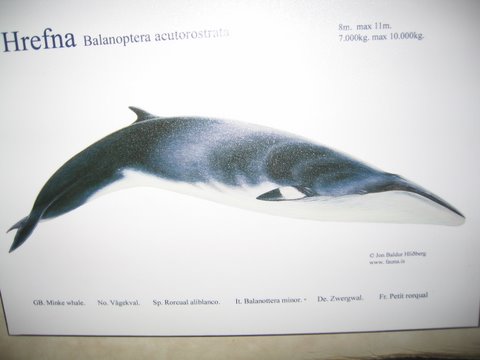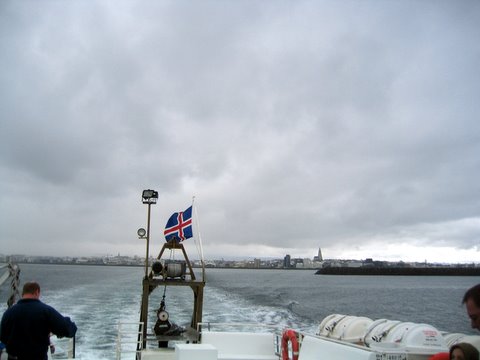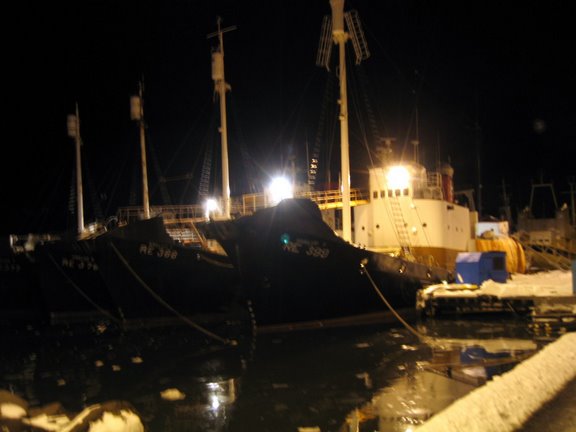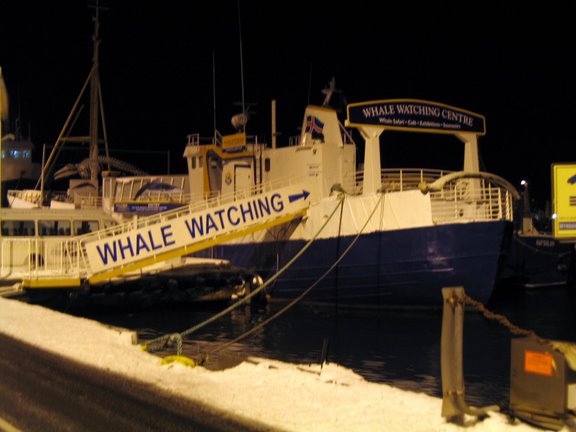

WHALING IN ICELAND
Icelanders have not been a whaling nation for very long. There are
records of whales stranded on the coast. These were cut up and eaten by poor farmers, sometimes the meat was
distributed to paupers. Indeed, it was like hitting the jackpot w All this unexpected meat, can you imagine? Still, there were no whaling expeditions among the inhabitants, like those still seen in the Faeroes Islands , where it is a tradition and a national sport to chase whales and make them strand. A bit like the corrida in Spain. And yes, at least the Faeroe Islanders eat their wretched victims meat
Some French and Basque ships used to hunt whales close to the Icelandic coast as early as the 17th century, and the king of Denmark, the then ruler of Iceland, banned whaling by non-Danes around Icelands coast, but it was the Norwegians who started whaling on an industrial scale in Iceland during the nineteenth century. They had motorized ships and overdid it, so there was no whale to be had for decades. Iceland became an independent republic in 1944. The whaling company called Hvalur (the Icelandic word for whale) was founded in 1948. It is still the only holder of whaling ships, and the interests of its owners are obvious as far as whaling is concerned. In 1986, Iceland signed an agreement as a member state of the International Whaling Commission, IWC, banning all whaling
temporarily. At the time, the whale exportation was said to be less than 1% of GDP. The ban was never really
implemented in Iceland, as the Icelandic whaling ships continued hunting whales on a small scale for scientific purposes. The
Icelanders eventually resigned from the IWC, but have now become a member state of the IWC again (since 2002).
During the last two decades, a new tourist attraction has become
The Icelanders argue that whales eat up a lot of fish, and are therefore competing with the fishermen. They also claim that some whale species have become far too big. There is no whale meat consumption to speak of among Icelanders. There is one traditional dish involving whale grease pickled in whey. This curious tidbit is a feature of the Þorrablót celebrations once a year, but it does not account for much. Most of the meat meant for human consumption used to be exported to Japan a long way off. Otherwise, the meat was exported to be canned as cat and dog food.
The Whale Watching boats are located at the same doc as the Whale boats, just a few meters a way. Inside the Whale Watching Centre, there is an interesting exhibition on whales.
Iceland whaling in a nutshell: In 1986, whaling used to account for about 2% of the countrys total
fishery export value, and 1% of the GDP.
|

 very popular with those visiting Iceland namely whale watching. Small motor boats sail around shores and shallows, enabling the tourists to spot
several species of whales. The whales seem to enjoy it, too, as they leap and frolick among the waves.
Whale-watching has become a kind of gold rush. This has also contributed to Iceland s image as a nature-friendly country. What an improvement from the days when Paul Watson of Sea Shepherd
had Hvalur ships sunk in the Reykjavík harbour. He was not charged, but anything resembling Greenpeace, WWF
or Sea Shepherd had to keep a pretty low profile in Iceland for years to come.
very popular with those visiting Iceland namely whale watching. Small motor boats sail around shores and shallows, enabling the tourists to spot
several species of whales. The whales seem to enjoy it, too, as they leap and frolick among the waves.
Whale-watching has become a kind of gold rush. This has also contributed to Iceland s image as a nature-friendly country. What an improvement from the days when Paul Watson of Sea Shepherd
had Hvalur ships sunk in the Reykjavík harbour. He was not charged, but anything resembling Greenpeace, WWF
or Sea Shepherd had to keep a pretty low profile in Iceland for years to come.
